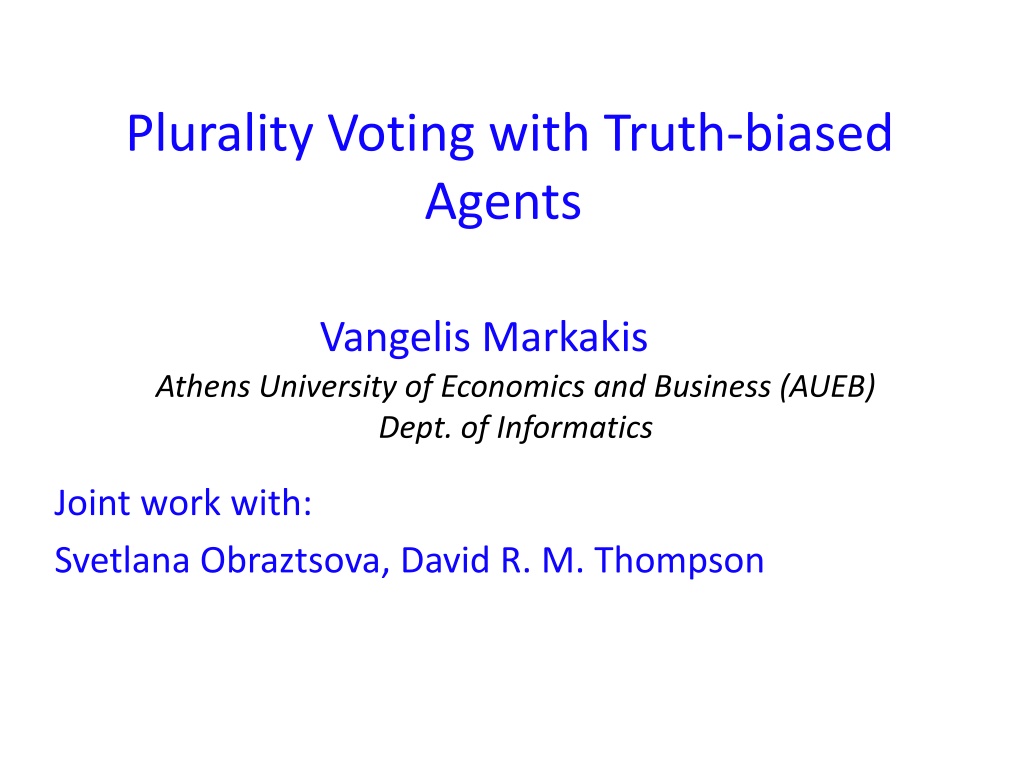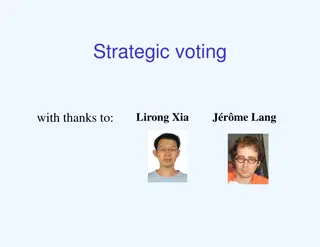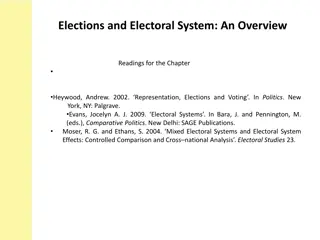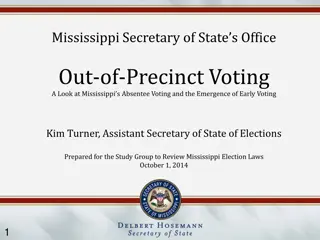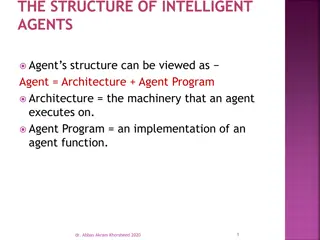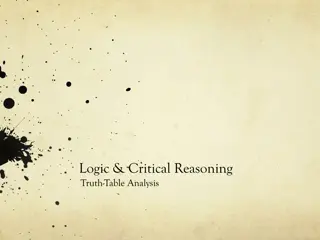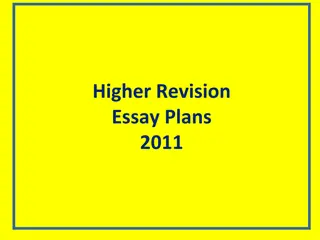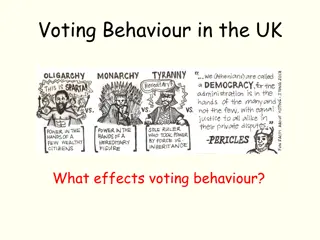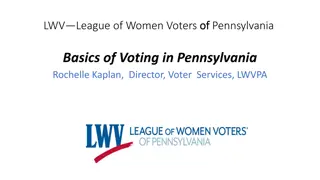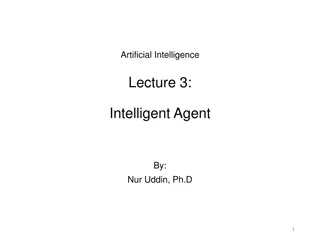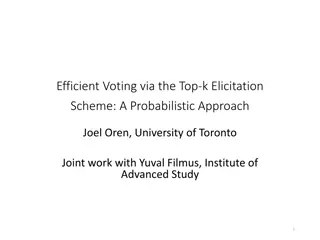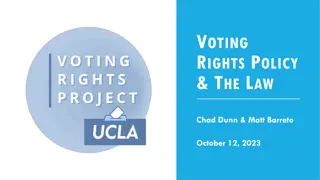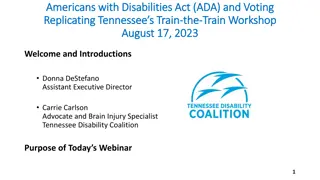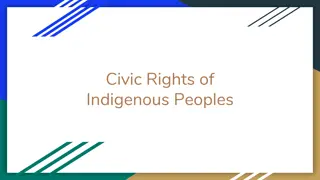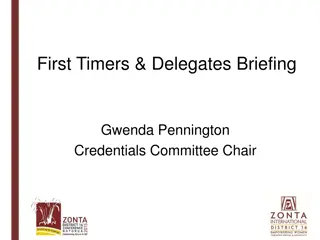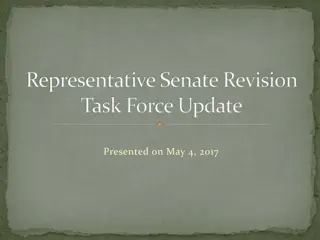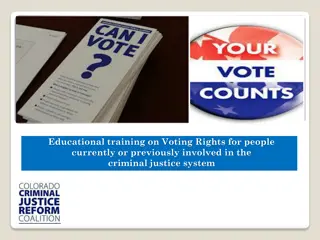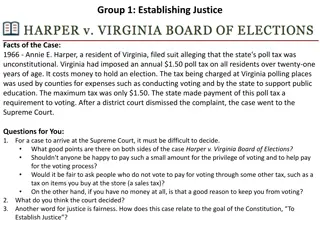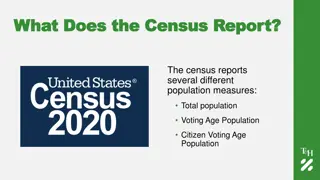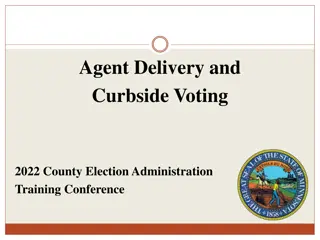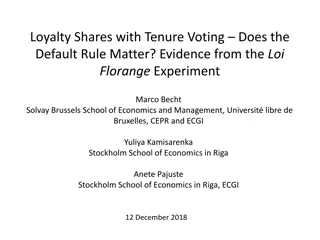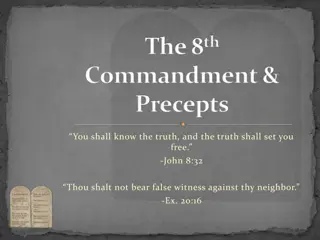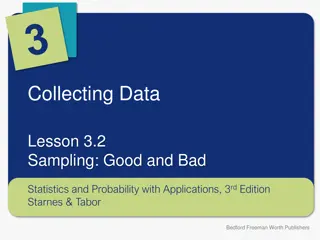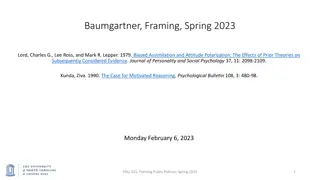Plurality Voting with Truth-biased Agents
Investigating game-theoretic approaches in voting, this research delves into the complexities of plurality voting with truth-biased agents, exploring Nash equilibria, strategic aspects, and undesirable outcomes. The study aims to provide a more realistic model of voting behavior and decision-making in elections.
Download Presentation

Please find below an Image/Link to download the presentation.
The content on the website is provided AS IS for your information and personal use only. It may not be sold, licensed, or shared on other websites without obtaining consent from the author. Download presentation by click this link. If you encounter any issues during the download, it is possible that the publisher has removed the file from their server.
E N D
Presentation Transcript
Plurality Voting with Truth-biased Agents Vangelis Markakis Athens University of Economics and Business (AUEB) Dept. of Informatics Joint work with: Svetlana Obraztsova, David R. M. Thompson
Talk Outline Elections Plurality Voting Game-theoretic approaches in voting Truth-bias: towards more realistic models Complexity and characterization results Pure Nash Equilibria Strong Nash Equilibria Conclusions 2
Setup Elections: a set of candidates C = {c1, c2, ,cm} a set of voters V = {1, ..., n} for each voter i, a preference order ai each ai is a total order over C a = (a1, , an): truthful profile a voting rule F: given a ballot vector b = (b1, b2, ,bn), F(b) = election outcome we consider single-winner elections 3
Setup For this talk, F = Plurality The winner is the candidate with the maximum number of votes who ranked him first Lexicographic tie-breaking: w.r.t. an a priori given order Among the most well-studied voting rules in the literature 4
Strategic Aspects of Voting Gibbard-Satterthwaite theorem For |C|>2, and for any non-dictatorial voting rule, there exist preference profiles where voters have incentives to vote non-truthfully 5
Strategic Aspects of Voting Beyond Gibbard-Satterthwaite: Complexity of manipulation Manipulation by coalitions Equilibrium analysis (view the election as a game among selfish voters) Study properties of Nash Equilibria or other equilibrium concepts 6
A Basic Game-theoretic Model Players = voters Strategies = all possible votes We assume all voters will cast a vote Utilities: consistent with the truthful preference order of each voter We are interested in (pure) Nash Equilibria (NE) [Initiated by Farquharson 69] 7
Undesirable NE under Plurality 5 voters deciding on getting a pet Truthful profile 8
Undesirable NE under Plurality It is a NE for all voters to vote their least preferred candidate! 5 voters deciding on getting a pet Problems with most voting rules under the basic model: - Multitude of Nash equilibria - Many of them unlikely to occur in practice Truthful profile 9
Can we eliminate bad NE? Some ideas: 1. Strong NE: No coalition has a profitable deviation [Messner, Polborn 04, Sertel, Sanver 04] Drawback: too strong requirement, in most cases they do not exist 2. Voting with abstentions (lazy voters) [Desmedt, Elkind 10] Small cost associated with participating in voting Drawback: it eliminates some equilibria, but there can still exist NE where the winner is undesirable by most players 10
Truth-biased Voters Truth-bias refinement: extra utility gain (by >0) when telling the truth if a voter cannot change the outcome, he strictly prefers to tell the truth is small enough so that voters still have an incentive to manipulate when they are pivotal More formally: Let c = F(b), for a ballot vector b = (b1, b2, ,bn) Payoff for voter i is: ui(c) + , if i voted truthfully ui(c), otherwise 11
Truth-biased Voters The snake can no longer be elected under truth-bias Each voter would prefer to withdraw support for the snake and vote truthfully 12
Truth-biased Voters Truth bias achieves a significant elimination of bad equilibria Proposed in [Dutta, Laslier 10] and [Meir, Polukarov, Rosenschein, Jennings 10] Experimental evaluation: [Thompson, Lev, Leyton-Brown, Rosenschein 13] Drawback: There are games with no NE But the experiments reveal that most games still possess a NE (>95% of the instances) Good social welfare properties ( undesirable candidates not elected at an equilibrium) Little theoretical analysis so far Questions of interest: Characterization of NE Complexity of deciding existence or computing NE 13
Complexity Issues Theorem: Given a score s, a candidate cj and a profile a, itis NP-hard to decide if there exists a NE, where cj is the winner with score s. Proof: Reduction from MAX-INTERSECT [Clifford, Poppa 11] ground set E, k set systems, where each set system is a collection of m subsets of E, a parameter q. ``Yes''-instance: there exists 1 set from every set system s.t. their intersection consists of q elements. 14
Complexity Issues Hence: Characterization not expected to be easy But we can still identify some properties that illustrate the differences with the basic model 15
An Example 1 2 3 4 5 6 Truthful profile a = (a1, ,a6) with 3 candidates Tie-breaking: c1 > c2 > c3 c1 = F(a), but a is not a NE c1 c2 c3 c1 c2 c3 c2 c3 c1 c2 c3 c1 c3 c2 c1 c3 c2 c1 1 2 3 4 5 6 Non-truthful profile b c2 = F(b), and b is a NE c1 c2 c3 c1 c2 c3 c2 c3 c1 c2 c3 c1 c2 c3 c1 c3 c2 c1 1 2 3 4 5 6 Non-truthful profile b c2 = F(b ), but b is not a NE too many non-truthful votes for c2 c1 c2 c3 c1 c2 c3 c2 c3 c1 c2 c3 c1 c2 c3 c1 c2 c3 c1 16
Warmup: Stability of the truthful profile Theorem: Let ci = F(a), be the winner of the truthful profile (1) The only possible NE with ci as the winner is a itself (2) We can characterize (and check in poly-time) the profiles where a is a NE Proof: (1) Simply use the definition of truth-bias. If NE b a, - true supporters of ci would strictly prefer to vote truthfully. - non-supporters of ci also do not gain by lying in b, hence they prefer to be truthful as well (2) The possible threats to ci in a are only from candidates who have equal score or are behind by one vote. Both are checkable in poly-time 17
Non-truthful NE Goal: Given a candidate cj, a score s, the truthful profile a, Identify how can a non-truthful NE b arise, with cj = F(b), and score(cj, b) = s 18
Key Properties under Truth-bias Lemma 1: If a non-truthful profile is a NE then all liars in this profile vote for the current winner (not true for the basic model) Definition: A threshold candidate w.r.t. a given profile b, is a candidate who would win the election if he had 1 additional vote Lemma 2: If a non-truthful profile b is a NE, then there always exists 1 threshold candidate (not necessarily the truthful winner) such candidates have the same supporters in b as in a Intuition: In any non-truthful NE, the winner should have just enough votes to win, otherwise there are non-pivotal liars 19
Conditions for existence of NE nj := score of cj in the truthful profile a c*:= winner in a, n* = score(c*, a) Claim: If such a NE exists, then nj s n* + 1, Lower bound: cj cannot lose supporters (Lemma 1) Upper bound: in worst-case, c* is the threshold candidate 20
Conditions for existence of NE Votes in favor of cj in b: nj truthful voters s nj liars Q: Where do the extra s nj voters come from? 21
Conditions for existence of NE Eventually we need to argue about candidates with: nk s nk = s-1 nk = s-2 All these may have to lose some supporters in b towards cj Except those who are threshold candidates (by Lemma 2) Notation: T: inclusion-maximal s-eligible threshold set i.e., the set of threshold candidates if such a NE exists we can easily determine T, given cj, s, and a M r: the set of candidates whose score is r in a 22
Conditions for existence of NE Main results: Full characterization for having a NE b with: cj = F(b) Score of cj = s Threshold candidates w.r.t. b = T , for a given T Implications: Identification of tractable cases for deciding existence Necessary or sufficient conditions for the range of s nj 23
Conditions for existence of NE Case 1: All candidates in T have score s-1 in a. We have a no"-instance if: - s-3 ( )M s-1\T s-nj nk ck M s-1\T yes -instance if: - s-3 ( )M s-2\T s-nj nk ck M s-2\T 24
Conditions for existence of NE Possible values for s - nj No NE b with cj = F(b) NE b with cj = F(b) 0 NP-hard to decide - s-3 ( )M s-1\T - s-3 ( )M s-2\T nk nk ck M s-1\T ck M s-2\T We can obtain much better refinements of these intervals Details in the paper 25
Conditions for existence of NE Case 2: There exists a candidate in T whose score in a is s. We have a no"-instance if: - s-2 ( )M s\T s-nj nk ck M s\T - s-2 ( )M s-1\T yes -instance if: s-nj nk ck M s-1\T 26
Strong Nash Equilibria Definition: A profile b is a strong NE if there is no coalitional deviation that makes all its members better off We have obtained analogous characterizations for the existence of strong NE Corollary 1: We can decide in polynomial time if a strong NE exists with cj as the winner Corollary 2: If there exists a strong NE with cj = F(b), then cj is a Condorcet winner Overall: too strong a concept, often does not exist 27
Conclusions and Current/Future Work Truth bias: a simple yet powerful idea for equilibrium refinement Iterative voting: study NE reachable by iterative best/better response updates Unlike basic model, we cannot guarantee convergence for best-response updates [Rabinovich, Obraztsova, Lev, Markakis, Rosenschein 14] Comparisons with other refinement models (e.g. lazy voters) or with using other tie-breaking rules? [Elkind, Markakis, Obraztsova, Skowron 14] 28
Conditions for existence of NE Case 1: All candidates in T have score s-1 in a. Then we have a no"-instance if: s - nj nk (s-3)|M s-1\T| ck M s-1\T yes -instance if: s - nj nk (s-3)|M s-2\T| ck M s-2\T - s-3 ( )M s-1\T s-nj nk ck M s-1\T 29
Key Properties under Truth-bias Lemma: If a non-truthful profile is a NE then all liars in this profile vote for the current winner (not true for the basic model) Definition: A threshold candidate for a given set of votes is a candidate who would win the election if he had 1 additional vote Lemma: If a non-truthful profile is a NE, then there always exists 1 threshold candidate Tie-breaking: 30
One more example Tie-breaking: 31
One more example Tie-breaking: 32
